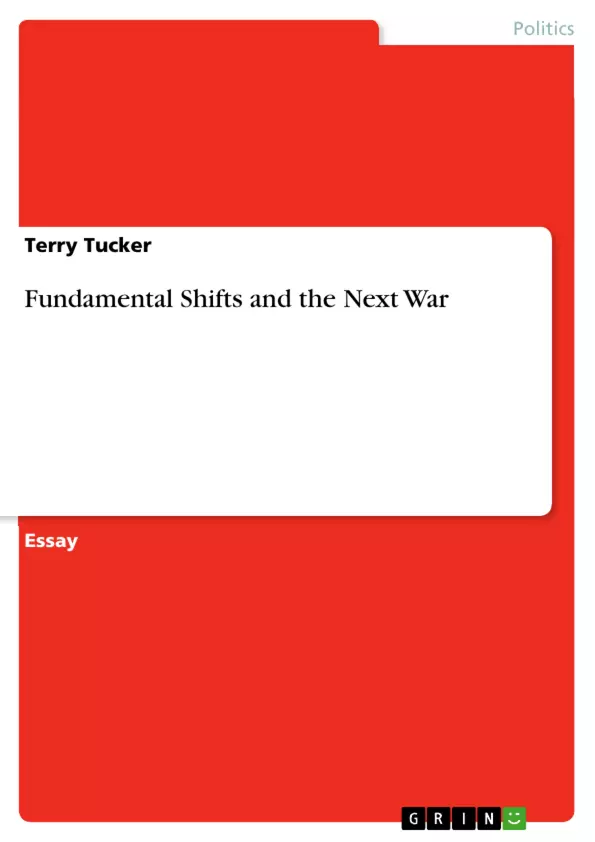Conflict in the present is compared to and understood to us from the lens of the past. The study of trends, history and military history seems to focus on why one loses a war and the consequences of winning or losing; primarily through the lens of tactical missteps and governmental mistakes
Inhaltsverzeichnis (Table of Contents)
- Purpose
- Background on Trends
- The United States Institute of Peace, Center for Post-Conflict Peace and Stability Operations
- Recent USIP Research brief on rebuilding political immunity and institutions in Afghanistan
- Recent examples of tactical progress
- Is the issue of fundamental shift a question still of what type of insurgency are we fighting?
- A particular trend over the last several years seems to be that "insurgency" is a separate body of work and that "terrorism" is also a separate body of work
- Defining what the change is determines the interpretation of what it is or is not
- Similar dissonance, interpretation, and ultimate methods to ways, means, and ends is felt when the question becomes one of: is this a stability operation or an counterinsurgency; is this a development project or reconstruction?
- Discourse, self evaluation, and peer evaluation is required for organizational change and improvement.
- Does the current debate and shift reflect this American way of war and characteristics? In this regard, is the fundamental question one of: Is the “Institution” making the distinction between "skill improvement training” or (institutional?) “Culture Changing Education\"?
Zielsetzung und Themenschwerpunkte (Objectives and Key Themes)
This document aims to provide insight into contemporary doctrinal and operational trends within the context of counterinsurgency operations. It explores the evolving landscape of insurgency, the importance of institutional strength, and the need for fundamental shifts in approach.
- The Nature of Insurgency: Examining the evolving definition and characteristics of insurgency, its distinction from terrorism, and its potential for social and political upheaval.
- The Role of Institutions: Understanding the significance of robust institutions at all levels – national, regional, and local – for achieving lasting stability and counterinsurgency success.
- Fundamental Shifts in Doctrine: Exploring the need for a paradigm shift in counterinsurgency strategy, moving beyond traditional approaches and embracing a more holistic understanding of the challenges and opportunities.
- The Importance of Culture: Recognizing the influence of culture and national identity on military doctrine and the need for institutions to adapt to cultural complexities.
- Learning and Adaptation: Emphasizing the importance of continuous learning, self-evaluation, and peer evaluation within military institutions to facilitate necessary adjustments and improve performance.
Zusammenfassung der Kapitel (Chapter Summaries)
- Purpose: This section introduces the document's objectives, highlighting the focus on contemporary doctrinal and operational trends in counterinsurgency operations.
- Background on Trends: This section delves into the changing landscape of insurgency, referencing a recent article discussing a flawed approach to warfare and emphasizing the importance of institutional strength.
- The United States Institute of Peace, Center for Post-Conflict Peace and Stability Operations: This section underscores the institute's emphasis on robust governmental institutions as essential for successful counterinsurgency operations. It also mentions key figures who contributed to the development of current counterinsurgency doctrine, including Gramsci and Galula.
- Recent USIP Research brief on rebuilding political immunity and institutions in Afghanistan: This section examines lessons learned from the Afghan context, highlighting the need for institutional reforms and emphasizing the importance of translating experience-based recommendations into concrete interventions.
- Recent examples of tactical progress: This section offers examples of localized operational success, demonstrating the potential for strategic gains through local-level engagement and institution-building.
- Is the issue of fundamental shift a question still of what type of insurgency are we fighting?: This section raises key questions surrounding the nature of modern insurgency, the relevance of classic counterinsurgency principles, and the need for a multi-layered approach to counterinsurgency operations.
- A particular trend over the last several years seems to be that "insurgency" is a separate body of work and that "terrorism" is also a separate body of work: This section explores the evolving terminology and distinctions between "insurgency," "terrorism," and "irregular warfare," highlighting the challenges of applying these concepts consistently and translating them into operational execution.
- Defining what the change is determines the interpretation of what it is or is not: This section discusses the need for clarity and precision in defining the nature of change sought by social movements and counterinsurgency efforts, emphasizing how differing interpretations can shape the strategies and methods employed by both sides.
- Similar dissonance, interpretation, and ultimate methods to ways, means, and ends is felt when the question becomes one of: is this a stability operation or an counterinsurgency; is this a development project or reconstruction?: This section explores the potential for semantic confusion and the importance of discerning subtle differences between operations, noting how differing interpretations can influence operational decisions and objectives.
- Discourse, self evaluation, and peer evaluation is required for organizational change and improvement.: This section emphasizes the importance of ongoing discourse, self-reflection, and peer evaluation for facilitating institutional change and improvement, drawing a parallel with scientific inquiry and the need to address anomalies.
- Does the current debate and shift reflect this American way of war and characteristics?: This section reflects on the potential for cultural and institutional influences on military doctrine and strategy, questioning whether current debates on fundamental shifts represent a need for "culture changing education" rather than simply "skill improvement training."
Schlüsselwörter (Keywords)
The document focuses on key themes such as counterinsurgency, insurgency, terrorism, irregular warfare, institutional development, fundamental shifts in doctrine, culture, national identity, operational trends, strategic objectives, learning, adaptation, and self-evaluation.
- Quote paper
- Professor of History Terry Tucker (Author), 2011, Fundamental Shifts and the Next War , Munich, GRIN Verlag, https://www.grin.com/document/165141



